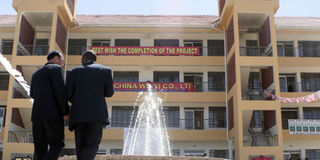The bruising battle for Athi River land

Great Wall apartments in Athi River. FILE PHOTO | NATION MEDIA GROUP
What you need to know:
Erdermann Properties Ltd, the developers of Greatwall apartments, accuses London Distillers Kenya of polluting the environment through smoke and other effluents making its 3,000 residential units unviable.
LDK says it started operations in the area in 1982 and Erdemann should not have been allowed to put up residential houses near a factory in 2014.
Environmentalists say poor planning by the defunct Athi River Municipality is to blame for the land use conflict.
The zoning crisis facing Athi River has burst into the open as industrial and residential developers jostle for space, violently in the latest case, in a conflict that could be replayed across Kenya’s urban areas where corrupt officials abet disregard of physical plans.
Initially styled as an industrial town, the town and its outskirts is now home to magnificent mansions and apartments.
Cheap land in the area and insatiable demand for housing are the key drivers of the conflict which has seen residents rise up in arms pollution by cement companies, meat processors and lately liquor mixers.
TUSSLES
Pollution in Athi River and other south eastern parts of Nairobi has been found to affect residents hundreds of kilometres away making those living from Kangemi to Limuru and Naivasha; and Kajiado to Magadi most at risk.
The tussles are now being played out in the legislative assembly and also on the streets as illustrated by a confrontation pitting Erdermann Properties Ltd, the developers of Greatwall apartments and London Distillers Kenya (LDK), a distillery.
Without delving into the merits of the arguments, Erdermann accuses the distiller of polluting the environment through smoke and other effluents making its 3,000 residential units unviable. Three weeks ago on April 9, the distiller’s staff clashed with a group of protesters claiming to be affected residents.
The group was later disowned by another claiming to be the genuine residents in what appears to be a high-stakes game playing behind the scenes.
NEMA
Erdermann claims LDK is operating illegally since it had been ordered by the National Environment Management Authority (Nema) to stop operations over breach of regulations through a letter dated February 6, 2017. Another letter written by Nema a week later shows LDK complied with the improvement order.
Nema, however, suggested in other correspondence that LDK had not replied to the letter ordering for improvement of effluent treatment and disposal. Mr Crispus Michira, the LDK Environmental Health and Safety Officer, took Nation through a tour of the factory to prove that LDK does not discharge effluent in a nearby river, saying its sewer system is connected to the Export Processing Zone (EPZ) sewerline.
A biogas plant extracts methane for internal use from the effluent before it is released to the sewer line.
Documents seen by Nation shows that Galot Industries, which owns LDK, was allocated the land (two parcels) in 1980 by the commissioner of Lands James Raymond Njenga. Under the grant the land was to be used for industrial and ancillary purposes only.
RESIDENTIAL HOUSES
Mr Michira says LDK started operations in the area in 1982 and Erdemann should not have been allowed to put up residential houses near a factory in 2014. He said authorities ignored their protests over the construction in 2016. Erdermann Marketing Officer John Rajwayi defends the project saying they secured all the approvals for construction.
He was, however, unwilling to discuss the pollution claims. In a 2015 paper titled ‘Simulations of Pollutant Dispersal Over Nairobi City, Kenya’ researchers Victor Ongoma, George Otieno and Onyango Augustine Omondi showed the sequence of pollution from Nairobi’s industrial area to other parts of the country.
“The winds in Nairobi city are mainly easterlies, implying that the pollutants are transported... southwest and northwest of the town,” they said.
“The transfer of pollutants is at 100 kilometres per hour,” they continued, “and therefore the city is left pollutant-free as the dust and other particles are blown elsewhere.”
Environmentalist Jeremiah Simba says poor planning by the defunct Athi River Municipality is to blame for the land use conflict.
While in the past the Athi River area was largely an industrial zone, it has recently attracted human settlement with factories, slums and upmarket apartments existing side by side.
POLLUTION
There have been complaints by residents over pungent odour from the Kenya Meat Commission factory and over dust particles cement companies which have clustered in the area. "As much as we want to blame the industries, we should also blame those who come to settle near factories and those who license the building of residential houses in an industrial zone," he says.
Mr Simba who is the Director of Semi-Arid Regions Environmental Services some pollutants such as noise from steel rollers in the area and offensive smell from slaughterhouses are prevalent in industries but can only be minimised, not eradicated.
KMC for instance, was ordered by the Nema Public Complaints Committee to either build coldrooms for the storage of the waste from the factory or ensure the waste was disposed of on a daily basis. With petitions on LDK already with Nema headquarters and the parliamentary environment committee, Mr Simba is hopeful a lasting solution will be found.





